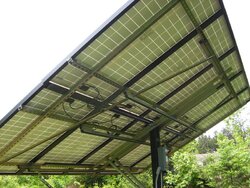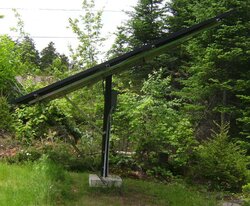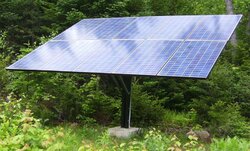I got a deal on closeout Evergreen Solar Modules over the winter and finally had time to get them installed on my prior pole mount. The racking is made with Unistrut. Due to the configuration of my inverter I installed 2100 watts (STC) of panels which I feel is "pushing" the capacity of Unistrut. The install went quick but startup got delayed a week due to an unknown prior issue with my existing inverter. My old panels were used monocrystalline while the new ones are amorphous. I havent done a lot of testing but it sure looks like the amorphous panels work better in less than blue sky conditions. On a clear day I am seeing 12 to 14 KWhrs per day, which should get me to the point that I generate more than I need on yearly basis
The array is adjusted for angle 3 times per year. The brace running down to the concrete post is a new addition to reduce twisting of the array during windy conditions. Do note, the pole is vertical, I must have held the camera crooked.
The array is adjusted for angle 3 times per year. The brace running down to the concrete post is a new addition to reduce twisting of the array during windy conditions. Do note, the pole is vertical, I must have held the camera crooked.




